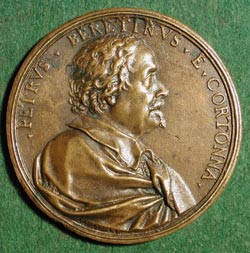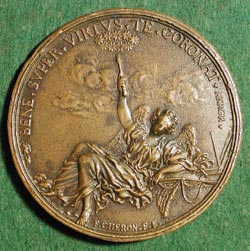

|
PIETRO DA CORTONA CHERON, Charles Jean Francois: France, 1669, Bronze
(cast), 72 mm Pietro Berrettini (called Pietro da Cortona) (1596-1669), a Florentine by origin, was an eminent Italian painter and architect. He was the founder of the Roman High Baroque style in painting and ranks as one of the great figures of the Roman Baroque. As he trained many pupils, his style was carried forth into the eighteenth century. Pietro specialized in highly illusionistic ceiling paintings in which paint is combined with stucco and gilt to create arresting effects. The greatest of these frescos are in Rome in the Palazzo Barberini and Chiesa Nuova, and in Florence in the Palazzo Pitti. His fresco ceiling in the Palazzo Barberini, Triumph of Divine Providence, is in the Italian Baroque style. Although he was less interested in architecture and regarded it as a pastime, his church of SS. Martina e Luca in Rome is of high quality; indeed, his architectural achievements are considered to be second only to Gian Lorenzo Bernini among seventeenth-century Roman architects. Besides excelling in painting and architecture, Pietro da Cortona, along with Peter Paul Rubens, designed the 13 tapestries now hanging in the Philadelphia Museum of Art, depicting the events in the life of Constantine the Great. The reverse legend of this medal is an anagram of the obverse titles. The piece appears to be an old after-cast. LINK to fresco by Pietro da Cortona Triumph of Divine Providence (from Web Gallery of Art) |
|